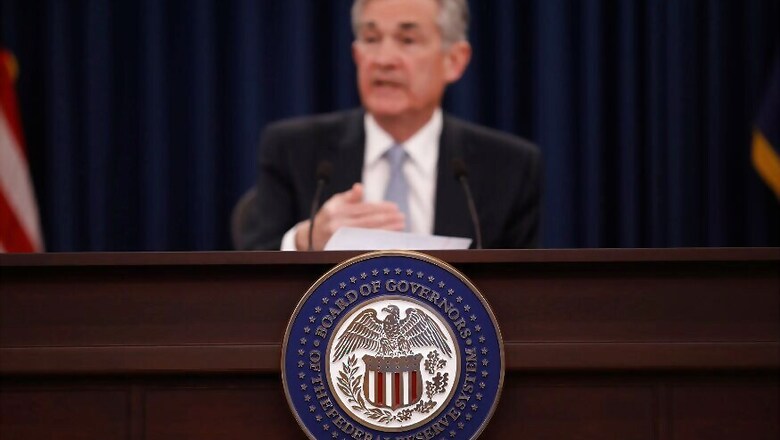
views
Washington: The Federal Reserve raised its key interest rate on Wednesday in a vote of confidence in the US economy's durability while signalling that it plans to continue a gradual approach to rate hikes for 2018 under its new chairman, Jerome Powell.
The Fed said it expects to raise rates twice more this year. And it increased its estimate for rate hikes in 2019 from two to three, reflecting more optimistic expectations for growth and low unemployment.
In a statement after its latest policy meeting, the Fed said it boosted its key short-term rate by a modest quarter-point to a still-low range of 1.5 percent to 1.75 percent. It also said it will keep shrinking its bond portfolio. The two moves mean that many consumers and businesses will face higher loan rates over time.
Taken together, the Fed's actions and forecasts suggest a belief that the economy remains sturdy even nearly nine years after the Great Recession ended.
The Fed's latest rate hike marks its sixth since it began tightening credit in December 2015, after having kept its benchmark rate at a record low near zero for seven years to help nurture the economy's recovery from the recession. Wednesday's action was approved 8-0, with the Fed avoiding any dissents at the first meeting Powell has presided over as chairman since succeeding Janet Yellen last month.
Bond yields and stocks initially rose after the Fed's announcement. But after wobbling for much of the afternoon, both ended modestly lower.
The Dow, having initially jumped as much as 250 points, ended down 44. The 10-year Treasury yield, a benchmark for mortgages and other loans, wound up at 2.88 percent, down from 2.90 percent a day earlier. It had traded as high as 2.93 percent after the Fed's statement came out.
Economists said the decision to raise rates despite some recent sluggish data in areas like consumer spending showed that the Powell-led Fed has faith in the economy's resilience.
"The Fed has more confidence in the economy's underlying momentum and appears to be more determined to normalise interest rates," said Mark Vitner, senior economist at Wells Fargo.
Vitner predicted that the central bank will end up raising rates four times this year despite its forecast for three.
Some investors had speculated that Powell might move to impose his mark on the Fed by signalling a faster pace of rate hikes for 2018. But the Fed's new economic forecasts, which include a median projection for the path of future increases, made no change to its December projection for three hikes this year.
If the Fed does stick with its forecast for three rate increases this year and three in 2019, its key policy rate would stand at 3.4 percent after five years of credit tightening. Wednesday's forecast put the Fed long-term rate — the point at which its policies are neither boosting the economy nor holding it back — at 2.9 percent.
At a news conference after the meeting, Powell said the Fed hasn't lowered its forecasts for growth because of the Trump administration's decision to impose tariffs on steel and aluminum imports. But he said the Fed's regional bank presidents have heard concerns from businesses about the consequences of the tariffs.
"Trade policy has become a concern going forward for that group," the chairman said, referring to business leaders.
But among the Fed officials who met in Washington this week, Powell said, "there's no thought that changes in trade policy should have any effect on the current outlook."
Powell's first news conference ended 15 minutes earlier than the roughly hour-long sessions Yellen typically held, primarily because he kept his answers shorter. Powell said he might choose to hold a news conference after each of the Fed's eight meetings each year, up from four now, but that he hadn't yet decided.
Wednesday's statement showed only minor changes from the text the Fed had issued in January after Yellen's final meeting. The statement described economic activity as rising at a "moderate rate," a slight downgrade from January, when the Fed described the economy as rising at a "solid rate."
The statement did not mention the extra government stimulus that has been added since the Fed's most recent economic forecast in the form of a $1.5 trillion tax cut and a budget agreement that will add $300 billion in government spending over two years.
But the Fed's new forecast does envision somewhat stronger economic growth compared with its previous estimate: It raises the estimate to 2.7 percent growth this year, up from 2.5 percent in the December projection, and 2.4 percent in 2019, up from 2.1 percent.
Those higher estimates may reflect the expected impact of the additional government spending. But they fall far short of the 3 percent annual growth that the Trump administration has argued will be achieved with the implementation of its economic program.
The US unemployment rate, now at a 17-year low of 4.1 percent, is expected to keep falling to 3.8 percent at the end of this year and 3.6 percent at the end of 2019, which would be the lowest rate in a half-century. The Fed expects inflation, which has run below its 2 percent target for six years, to stay at 1.9 percent this year and reach 2 percent in 2019.
A healthy job market and a steady if unspectacular economy have given the Fed the confidence to think the economy can withstand further increases within a still historically low range of borrowing rates.


















Comments
0 comment